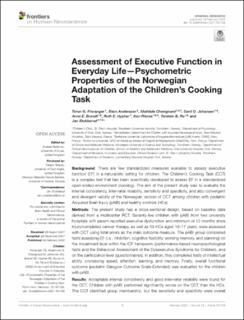| dc.description.abstract | Background: There are few standardized measures available to assess executive function (EF) in a naturalistic setting for children. The Children’s Cooking Task (CCT) is a complex test that has been specifically developed to assess EF in a standardized open-ended environment (cooking). The aim of the present study was to evaluate the internal consistency, inter-rater reliability, sensitivity and specificity, and also convergent and divergent validity of the Norwegian version of CCT among children with pediatric Acquired Brain Injury (pABI) and healthy controls (HCs).
Methods: The present study has a cross-sectional design, based on baseline data derived from a multicenter RCT. Seventy-five children with pABI from two university hospitals with parent-reported executive dysfunction and minimum of 12 months since injury/completed cancer therapy, as well as 59 HCs aged 10–17 years, were assessed with CCT using total errors as the main outcome measure. The pABI group completed tests assessing EF (i.e., inhibition, cognitive flexibility, working memory, and planning) on the impairment level within the ICF framework (performance-based neuropsychological tests and the Behavioral Assessment of the Dysexecutive Syndrome for Children), and on the participation level (questionnaires). In addition, they completed tests of intellectual ability, processing speed, attention, learning, and memory. Finally, overall functional outcome (pediatric Glasgow Outcome Scale-Extended) was evaluated for the children with pABI.
Results: Acceptable internal consistency and good inter-rater reliability were found for the CCT. Children with pABI performed significantly worse on the CCT than the HCs. The CCT identified group membership, but the sensitivity and specificity were overall classified as poor. Convergent validity was demonstrated by associations between the CCT and performance-based tests assessing inhibition, cognitive flexibility, and working memory, as well as teacher-reported executive dysfunction (questionnaires). Divergent validity was supported by the lack of association with performance-based measures of learning and memory, attention, and verbal intellectual ability. However, there was a moderate association between the CCT and performance-based tests of processing speed. Lastly, better performance on the CCT was associated with a better functional outcome.
Conclusion: Our study with a relatively large sample of children with pABI and HC’s demonstrated good psychometric properties of the CCT. CCT performance was associated with the overall level of disability and function, suggesting that CCT is related to the level of activity in everyday life and participation in society. Hence, our study suggests that the CCT has the potential to advance the assessment of EF by providing a valid analysis of real-world performance. Nevertheless, further research is needed on larger samples, focusing on predictors of task performance, and evaluating the ability of CCT to detect improvement in EF over time. The patterns of error and problem-solving strategies evaluated by the CCT could be used to inform neuropsychological rehabilitation treatmentand represent a more valid outcome measure of rehabilitation interventions. | en_US |

